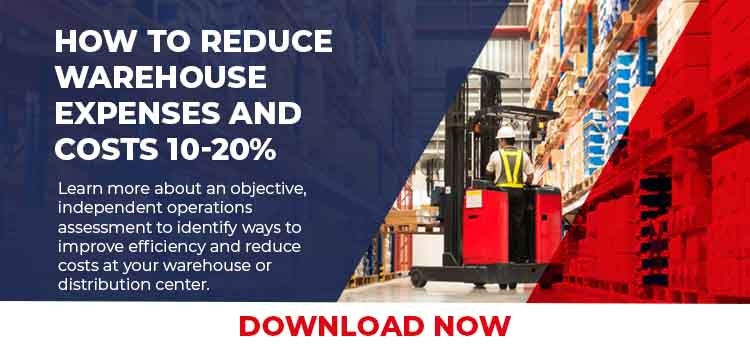There is no end to the process of reducing labor effort, shortening processing times, making better use of warehouse space, costs and error reduction. To be competitive, have flexibility in fulfillment operations, and survive - a process of continuous process improvement is critical in warehouse and distribution activities today.
Warehouse and distribution process improvement takes into account the processes for doing work within the facilities, and the Supply Change in total. There are huge benefits when you look at processes, systems, layout and use of space in totality. What changes to these can be made which positively affects their use and integration.
As you look at processes and costs, most warehousing costs are fixed, while departmental labor of picking, packing, receiving, put-a-way, shipping and returns is variable. The variability of hours and costs spent change by season and week. Process change in most warehouses and distribution centers should focus on labor which is a major factor operations managers have control over.
Excluding transportation, if you look at fulfillment center expenses, they can be summarized into these cost categories: direct labor, indirect labor, total facilities costs (building, systems, automation, utilities) and packing material costs. In many centers labor is more than 50% of the total warehouse costs. In many businesses, transportation is the biggest single cost larger than all other costs combined.
Here are nine factors that will make warehouse process improvement projects successful:
1. Use Metrics as Indicators
From today’s IT systems, you can get a myriad of data points. However, which are indicators of the operations that lead to taking action? To paraphrase British scientist Lord Kevin, “You can’t improve something you haven’t measured." Do you have indicators and standards for inventory accuracy, inventory turnover; total warehouse costs per order, cost per line, cost per package shipped? Do you have a measure of space availability? What are the reasons for errors, and what does an error cost you?
If you cannot measure key areas, maybe that should be a critical starting point.
READ: Benchmarking Metrics of Warehouse Operations
2. Process Flowcharts
Creating process flowcharts is a skill and experience many warehousing, distribution and systems people have not had before. They take a lot of time but they create a visual to understand how things are currently working. We don’t use them in every process change assignment, but they have high value in major changes.
Some managers are not “hands-on”, or they have grown up in the business, so they assume they know how things get done. Charting workflow shows the relationships between processes and processes interact. They also show how outside areas affect operations and potential gaps.
3. Consider the Entire Supply Chain
Look at the supply chain in total. Major systems and services affect your warehouse and distribution center operations and costs. Some of the major areas to review are how purchases are placed, and the vendor and business systems interfaces; adding distribution center locations to be closer to customers, lowering freight cost and order time-in-transit; what improvements can be made in vendor compliance to reduce costs, rework and merchandise not ready to ship in your warehouse.
4. Develop Several Options
As you are assessing your operation and planning changes, people often jump at the first option. Ask what other options are there? From that what are the ramifications for capital investments; cost reduction, implementation schedule and flexibility.
5. Prerequisites for Implementing Change
Many times, there are foundational pre-requisites that must be implemented first to achieve a new level of operation, system or facility. Here is an example of four foundations necessary to achieve the highest benefit from a new WMS:
- Warehouse aisle mapping and barcode labeling of all warehouses, zones, aisles, levels and bin and slot locations;
- Appropriate scanning technology and wireless access points (WAP) to collect all data on-line, real time throughout the warehouse;
- Barcode labeling of all products, largely through vendor source labeling and some internal labeling;
READ: 4 Foundation Prerequisites to Maximize E-commerce WMS Benefits
Implement barcode-based process changes to dramatically increase accuracy, with speed and with decreased errors. As you are studying processes, what are the prerequisites needed before reaching the proposed solution?
6. Identify Amount of Change
Major changes in systems, processes and operations, often requires massive effort. More than 50% of all major projects are not installed on-time and within budget. Analyze your operation broadly but implement narrowly - implement the low hanging fruit with the highest benefits for the capital costs.
7. Return on Investment
When a large IT or warehouse project is proposed, we always get two immediate questions from management: How much will it cost, and how soon can we get a return on investment? A thorough ROI study will help you understand current vs. annual costs, total cost of ownership, implementation and what organizational changes will be encountered. These considerations should be applied to any information system, technology project, warehouse expansion or major change requiring capital.
8. Get Early Employee Involvement
Involve your staff from the very beginning. They know where the breakdowns in process and systems are. Early involvement and buy-in to problems and solutions makes for a successful implementation.
Who will project manage a major process change? Can you do this with internal personnel? Identify early on if you need outside expertise to review your project and potentially offer industry ideas and solutions.
9. Continuously Improve Processes
Unfortunately, many major studies are initiated but never implemented. Commit your organization to a culture of continuous improvement process. Challenge your employees to bring you changes which will add value and improve customer service. It’s not an annual after-holiday event but an ongoing process.
Process improvement has great promise for most companies to reduce costs and improvement customer service.







SHARE